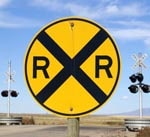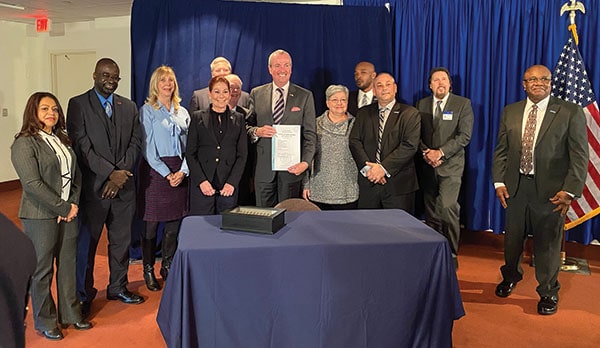New Jersey Gov. Phil Murphy signed S. 3425 into law on Jan. 9, a bill requiring rail carriers to maintain vegetation near and around crossings in the state.
The bill passed through the New Jersey Senate last May by a unanimous 35-0 vote and later in December was approved unanimously by the state’s Assembly.
It requires vegetation to be cleared by at least 300 feet from crossings by rail carriers. If the carriers do not comply within 15 days of receiving written notice that a crossing must be cleared, then the state Department of Transportation will clear the vegetation and charge the carriers for the cost of doing so.
“Excessive vegetation has the potential to cause harm to commuters, railroad workers, and many others,” said SMART-TD New Jersey State Legislative Director Ronald Sabol. “Thank you to the governor for signing this important legislation that will improve safety across our statewide rail system.”
Sen. Patrick J. Diegnan, Jr. of New Jersey’s 18th District was the bill’s primary sponsor.
Tag: grade crossings

“The U.S. Department of Transportation has made increasing safety at highway-rail grade crossings, especially along routes transporting energy products, one of its top priorities,” said U.S. Transportation Secretary Anthony Foxx. “This money allows the Department to support innovative ideas and solutions developed at the local level, and I encourage states to apply for this funding.”
Highway-rail grade crossings collisions are the second-leading cause of all railroad-related fatalities. Last year, 269 individuals died in these collisions. While the number of fatalities has decreased for the last several decades, this number increased last year for the first time this decade.
Highway-rail grade crossing accidents are frequently the result of a driver’s lack of awareness of a crossing or an oncoming train or a driver’s attempt to “beat the train.” Earlier this year, FRA ramped up its campaign to prevent collisions and save lives at highway-rail grade crossings through greater education, stronger enforcement and smarter engineering. To accomplish this, FRA has developed key partnerships, and has:
- Worked with Google and other technology companies to integrate FRA’s grade crossing location data to provide audio and visual alerts when using turn-by-turn navigation applications;
- Partnered with local law enforcement agencies to increase enforcement at railroad crossings; and
- Supported research on grade crossing technology.
“Most of these deaths are completely preventable, and that is why the Federal Railroad Administration has redoubled its efforts to reverse last year’s upward trend. These funds will allow states to take innovative ideas and make them a reality to increase safety and decrease fatalities,” said FRA Acting Administrator Sarah Feinberg.
In GROW AMERICA, the U.S. Department of Transportation (DOT) has proposed creating new grant program that would make $250 million available to local communities for highway-rail grade crossings as well as other critical rail infrastructure projects. In addition, the Department has proposed continuing Federal Highway Administration’s $220 million per year dedicated grant program for highway rail grade crossing projects.
Earlier this year, DOT released its comprehensive rule that raises the bar on the safety of transporting crude oil by rail. The rule requires stronger tank cars and 21st century electronically controlled pneumatic (ECP) brakes that activate simultaneously on all tank cars, reduce the distance and time needed for a train to stop, and keep more tank cars on the track if a train does derail. DOT has also required that railroads transporting crude oil notify State Emergency Response Commissions of the movement of crude oil through individual states. During the last two years, DOT has taken more than two dozen actions to increase the safety of transporting energy products by rail.
View a copy of the Notice of Funding Availability.
To view education materials, visit Operation Lifesaver’s website, our partner in grade crossing and trespasser safety.

The next phase of FRA’s efforts to improve safety at grade crossings will aim to employ smarter uses of technology, increase public awareness of grade crossing safety, including distracted driving, improve signage, work closer in partnership with states and local safety agencies, and call for new funding for greater safety at grade crossings.
“Recent accidents in New York and California are important reminders of our shared challenge to both educate the public about grade crossing safety, and to enforce appropriate behavior around railroad operations,” said U.S. Transportation Secretary Anthony Foxx. “Grade crossing and trespassing accidents are serious challenges to maintaining public safety. Every three hours of every day, someone is hit by a train in the United States and we must do all we can to heighten public awareness, strengthen enforcement efforts and pioneer new technologies to better secure public safety.”
There are 250,711 grade crossings in the United States; about 51 percent of those are public-at-grade crossings. Only half of all public grade crossings have automatic-warning systems and only a third have flashing lights and gates. Approximately 15 percent of all grade crossings are grade separated – the safest of all crossings – meaning railroad traffic is completely separated from vehicle and pedestrian traffic.
States and localities have traditionally played the most significant role in determining the type of warning system present at grade crossings, with most system decisions determined by traffic levels. Upgrades to existing grade crossings are also the responsibility of states and local communities. Under federal law and regulations, railroads are responsible for inspecting, testing, and maintaining highway-rail grade crossings. The FRA issues and enforces regulations on crossing safety, issues guidance on best practices and conducts research on ways to improve crossings safety.
Additionally, the federal government provides more than $287.9 million annually to states to help improve and enhance safety at public grade crossings.
“The reality is that while the overall number of deaths and injuries from grade crossing incidents has come down significantly over the last two decades, this remains a serious problem. We can and should be doing everything we possibly can to keep drivers, pedestrians, and train crews and passengers safe at grade crossings,” said Sarah Feinberg, Acting Administrator at the Federal Railroad Administration. “In addition to this renewed outreach to law enforcement, FRA will take a fresh look at our grade crossing programs and activities.”
Facts on grade crossings:
- 239 people were killed and 763 people were injured in grade crossing incidents in 2014.
- In Fiscal Year 2014 the top ten states with the most grade crossing accidents in ranking order include: Texas; California; Illinois; Indiana; Georgia; Alabama; Louisiana; Ohio; Florida; Tennessee.
- The FRA, in partnership with the Federal Highway Administration and State Departments of Transportation have worked together with railroads to close more than 18,000 grade crossings nationwide since 2008.
To learn more about the problem at grade crossings or to view our Highway-Rail Grade Crossing Resource Guide for reporters, visit our press room at http://www.fra.dot.gov/Page/P0095.

It turned out to be a fatal move. Her car became stuck on the tracks as a train barreled toward her. She dialed 911 to ask if the train could be stopped. Moments later came a horrible collision. Passersby pulled Kruger-Small from the wreckage, but it was too late.
Read the complete story at NBC4.

Safety Advisory 2013-04 also notes that “under certain circumstances, particularly where human error is involved, the fail-safe features [of warning systems] can be deactivated or circumvented, creating the potential for an accident. FRA has found that serious highway-rail grade crossing accidents and false proceed signal failures have occurred due to human error.”
According to the FRA, the most effective practices to prevent this include requiring railroad employees to obtain proper authority from the train dispatcher or other appropriate personnel responsible for the movement of trains through the territory before disabling a warning or signaling system, and a requirement that all disabled systems be properly inspected and tested to ensure they operate as designed before being restored to service.
The list of recommended actions include:
1. Each railroad responsible for the proper operation of a highway-rail grade crossing warning system or wayside signal system review and evaluate its specific railroadwide instructions for the proper method for temporary removal of these systems from service. These instructions should address the following items:
- a. The manner in which the deactivation is authorized.
- b. The personnel designated to authorize deactivation.
- c. The protocols for notifying appropriate persons, especially personnel responsible for the movement of trains, that a grade crossing warning system or wayside signal system has been temporarily removed from service.
- d. The appropriate methods of providing for the safety of train movements while the grade crossing warning system or wayside signal system is temporarily removed from service.
- e. The requirements necessary to perform an inspection and operational test of the pertinent system components before restoring the grade crossing warning system or wayside signal system to service.
- f. The protocols for documenting and notifying appropriate persons that the grade crossing warning system or wayside signal system has been properly tested and restored to service.
2. Each railroad provide regular periodic training to all affected employees to ensure their understanding of instructions for the proper procedures for the temporary removal from service of grade crossing warning or wayside signal systems, including the proper use of jumper wires.
Highway-rail grade crossing warning devices and wayside train signals are among the most important safety systems in the railroad industry for preventing train collisions and highway-rail grade crossing accidents. Despite the high degree of reliability of these systems, failures occasionally do occur.
FRA previously made related recommendations to railroads regarding the importance of clear safety procedures to ensure the safety of highway-rail grade crossing warning systems and wayside signal systems in Safety Advisory 2002–01.
To read the complete advisory and background, which was published June 3 in the Federal Register, click here.
